I’ve been challenged, recently,
about my interpretation of the Judgment card.
In a reading, I’d said that Judgment wasn’t about judging and being
judged – or at least, not only about that. But
others clearly don’t agree, so I thought I’d have a look and see what other
views are around.
 |
© Judgement
Universal Waite Tarot
|
The Little White Book (LWB) that
accompanies the Universal Waite Tarot deck simple says “Change of position, renewal, outcome.” Short and to the point.
Rachel Pollack, in her Seeker: The Tarot Unveiled (Llewellyn, 2005), adds “rebirth, new
possibilities, and wholeness” to the list.
In fact, she maintains (as do I) that Judgment is not about judging
others, showing good judgement, or being judged themselves at all. The child in the image reminds us that new
opportunities and possibilities can appear when we heed the voice that tells us
to let go of old, out-of-date, ways and beliefs. The nakedness of the figures symbolizes
openness as well as new beginnings – the state in which we were born into this
world, but also the state in which we need to embrace this “re-birth”. The trumpet, far from being the call to
judgement, is in fact the “voice”, the push, the call – however it manifests –
to step into the unknown and stop hiding.
 |
© Judgement
Game of Thrones Tarot
|
Juliet Sharman-Burke, in her Beginners Guide to the Tarot (Connections, 2001),
adds “resurrection and resolution” to the list.
She too sees this as an opportunity to greet the new with joy. She calls it the card of karma, saying “it
heralds the time of reaping what has been sown”. You might see an element of judgement in that
but, reading between her lines, I feel it’s more about assessment. Yes, she does use the word “judge” – “to
judge your actions and appraise what you have done” – but she goes on to say it’s
more about the preparation for the next stage in life.
Liz Dean, in the accompanying guidebook to The Game of Thrones Tarot (Home Box Office, Inc., 2017), doesn’t use the word “judgement” in her description of the card. She writes about being on the edge of a change, and focuses on the need for second chances after a review or appraisal, and about the chance to make sense of the past.
 |
© Judgement
Shadowscapes Tarot
|
The creators of the Wildwood Tarot (Connections, 2011), Mark Ryan and John
Matthews, are very clear in their view.
In the accompany book, they write that “The major element in this
process [surviving inevitable change] is judgement of yourself and others.”,
yet the word “judgement” doesn’t come up in their list of keywords. “Karma” and “cosmic law” do, as does “inescapable
truth”. They do talk about renewal and
rebirth, themes that are echoed in the image that Will Worthington has created
for the card. That idea of rebirth is
also seen in the DruidCraft Tarot’s image (also by Will Worthington).
 |
© The Great Bear
Wildwood Tarot
|
 |
© Rebirth
Druid Craft Tarot
|
 |
© Judgement
Wild Unknown Tarot
|
Beginner’s Guide to
the Tarot created by Juliet Sharman-Burke, illustrated
by Giovanni Caselli, published by Connections
Druid Craft Tarot created by Philip
Carr-Gomm and Stephanie Carr-Gomm, illustrated by Will Worthington, published
by Connections
Game of Thrones Tarot, created by Liz
Dean, published by Home Box Office, Inc., 2017
Shadowscapes Tarot created by
Stephanie Pui-Mun Law and Barbara Moore, published by Llewellyn
Universal Waite
Tarot created by Mary Hanson-Roberts & Pamela Colman-Smith, published by
U.S. Games Systems, Inc.
Wild Unknown Tarot, created by Kim
Krans, published by HarperCollins, 2016.
Wildwood Tarot created by Mark
Ryan and John Matthews, illustrated by Will Worthington, published by
Connections













